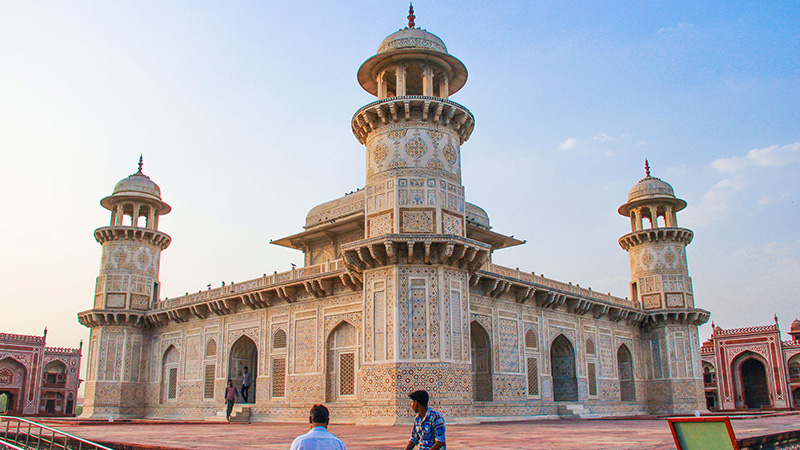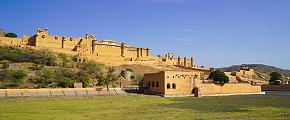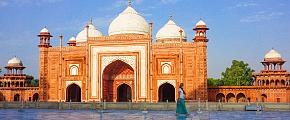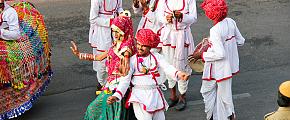Top 10 cultural wonders to visit in India
India, the birthplace of human civilization and Buddhism has a splendid history and culture. Diversified cultural relics, imperial palaces, ancient castles, and observatories are shining with the wisdom of ancient Indians.
Many of these scenic spots are also world heritage sites, which are of special significance. They are worthy to stop by on an India tour.
Taj Mahal
Taj Mahal, one of the most famous scenic spots in India and a world cultural heritage, was regarded as the "New Seven Wonders of the World".
Taj Mahal is a huge tomb mosque built of white marble. It was built by the Mughal emperor Shah Jahan in Agra from 1631 to 1648 in memory of his beloved wife. It is located on the right side of the Yamuna River in Agra, Uttar Pradesh, more than 200 kilometers away from New Delhi. Taj Mahal is composed of halls, bell towers, minarets, pools, etc., all built with pure white marble and inlaid with glass and agate, which owns high artistic value.
In addition to bringing together the best architects and craftsmen in India, the construction of the Taj Mahal gathered architects and craftsmen from the Middle East and Iran. There is no doubt that the Taj Mahal is a model of perfect art in the world. It demonstrates various characteristics at different times of the day. But early morning is surely the best time to avoid the crowds.
 Taj Mahal, Agra
Taj Mahal, Agra
Humayun's Tomb
The garden mausoleum of King Humayun is another typical architectural masterpiece of the Mughal period. You may think that its "onion" shape resembles the Taj Mahal - actually, it was inspired by the design of the Taj Mahal!
This solemn Persian architecture, as always, shows the characteristics of the powerful Mughal Empire, which features be grand and magnificent. Meanwhile, it is full of the geometric beauty of Islamic architecture.
The main building is made of red sandstone. The mausoleum is square with a semicircular roof and surrounded by doors. It can be a masterpiece in the architectural history of India and even the world.
Nearby the mausoleum, there is a small museum, which displays photos of the mausoleum, demonstrating the evolution of the Mughal mausoleum architecture.
 Humayun's Tomb, Delhi
Humayun's Tomb, Delhi
The Jantar Mantar
Jantar Mantar is situated in the dry land of the pink city of Jaipur, Rajasthan. It is an astronomical observation site that introduces us to the earlier forms of astronomical studies in India. It reflects the traditional ways in which science and astronomy have transformed, the monument is a reminder of ancient astronomy and engineering.
There are 13 star gazing instruments present in this astronomical site. It was built during the reign of Maharaja Jai Singh II of Jaipur, from 1724 onwards.
In all of India, the rajah had established 5 such observatories. The observatory's duties included arranging cosmic tables and predicting the epochs and developments of the sun, moon, and planets. Unfortunately, because of the high structures all around it, the observatory can no longer be used. There are plans to attempt to restore this amazing structure to the way it once operated. It is as rare as it is stunning.
Gateway of India
Gateway of India, the symbol of Mumbai, is located at the Apollo Bunder in Mumbai.
Facing Mumbai Bay, it is an arch integrating Indian and Persian cultural architectural features. It is 26 meters high and was built in 1911 to commemorate the visiting King George V and Queen Mary.
It allows Majesty to pass through the gate to show that Mumbai is the gateway of India. This arch is a Gujarati-style building, while Its form is very similar to the French Arc de Triomphe.
So far, Gateway of India has become one of the must-do for tourists, as well as an important venue for the government to welcome guests from all over the world.
Amer Fort
Amer Fort also known as Amber Fort is situated in the pink city of India, Jaipur. With its immense rich culture and heritage, the fort symbolizes traditional architecture. The stunning fort consists of an exquisite royal palace, bastions, huge courtyards, multiple gates and cobbled pathways. The location is actually a visual treat owing to its elaborate carvings, mirror, and stone carving on the walls and ceilings. There are four main sections of the fort, each with its own gate and courtyard.
The palace was the residence of the Rajput Maharajas and their families. There's a Shila Devi Temple in the fort, which was considered the incarnation of Kali, the goddess of death and time and the symbol of motherly love. According to the legend, this is the place where different sacrifices happened in order to help the army win its battles.
 Amber Fort, Jaipur
Amber Fort, Jaipur
Group of Monuments at Hampi
Hampi is the last capital site of the Indian Empire of Vijayanagar. Between the 14th and 16th centuries, the extremely rich princes built the magnificent Victory City, the amazing Dravidian temples, and magnificent palaces.
Today, Hampi City is one of the most important archaeological areas in the world, and it is an important center of Brahman culture and Dharma art.
The Hampi Monument Group is massive, with huge stones and broken eaves and walls of the palace. The two-story lotus-shaped house decorated with recessed arches, located in the enclosure dedicated to women, is a very attractive place. The open-air Queen's Bathroom is built with many arched corridors and prominent balconies.
Temples built of huge rocks can be seen everywhere, but the most popular incense is the Virupaksa Temple in the center of the relics. Siva, the god of destruction, is enshrined in the Virupaxsa Temple.
Harmandir Sahib
Sri Harmandir Sahib temple, known as the Golden Temple is the holiest shrine of Sikhs. located in Amritsar, India. it is visited by thousands of pilgrims.
Founded in 1577 by the fourth Sikh master Guru Ram Das, it is not only a central religious place of the Sikhs but also a symbol of human brotherhood and equality.
Sri Harmandir Sahib has a unique charm with Sikh architecture. the gilded buildings will shine. Among them, Adi Granth (Guru Granth Sahib) has a silver canopy decorated with several gemstones.
In addition, the establishment of this temple aims to provide a place for believers from all walks of life and religions to worship God on an equal footing. Every day, more than 100,000 people come to visit the sacred paradise.
 Harmandir Sahib, Amritsar
Harmandir Sahib, Amritsar
Archaeological Site of Nalanda Mahavihara
The temple archaeological site is located in Bihar Pradesh. Many exquisite Buddhist stone carvings have been unearthed here, some of which are only the size of fists, and the Buddhist stories carved on them are extremely exquisite. In addition, bronze statues, plates, and seals were unearthed as well.
In the 5th century AD, to inherit Buddhism, a Buddhist university, Nalanda Temple, was founded. It was the highest institution and academic center of ancient Indian Buddhism and once attracted thousands of scholars from all over the world. Unfortunately, it was destroyed by war, leaving behind merely a relics park with an area of about one square kilometer.
Today, Nalanda Temple is divided into a monastery area and a lecturing area. There are many pagodas scattered around, of which the real-body Buddhist relics stupa is the most magnificent one. This pagoda has three layers, and its appearance is carved with exquisite Buddhism patterns.
Konark Sun Temple
Located in Konarak, nearby the Bay of Bengal, India, the Sun Temple is a Hindu temple built in the 13th century. Konarak Village, a small town with a population of less than 20000, now is famous for its ancient Hindu architectural treasures.
The sun temple in Konarak is dedicated to Surya, the Hindu sun god. The Temple demonstrates the image of Surya driving a chariot. The stone chariot is about 30 meters high, with 12 pairs of stone wheels and 7 stone steeds pulling the chariot. The unique charm lies in the fabulous carvings, which represent the artistic style of that era.
Although today most of the architecture is destroyed, half of the original ones are maintained well. It is rare to find such a large number of well-preserved group sculpture architectures. In 1984, the Sun Temple was listed as a world cultural heritage by UNESCO, and it is still the main pilgrimage site of Hindus. Every February, Hindus gather here to participate in Chandrabhaga Mela.
Ajanta And Ellora Caves
Ajanta and Ellora caves situated in the district of Aurangabad, Maharashtra. With artwork from the 600–1000 CE era, Ellora cave is one of the world's largest Hindu temple cave complexes. The Kailash temple, a Shiva-dedicated structure in the shape of a chariot, is located in Cave 16, and it is the largest monolithic rock excavation in the entire globe. The excavation of the Kailash temple also uncovered sculptures of numerous Hindu deities as well as relief panels that summarized the two main Hindu epics. The Ajanta Caves are about thirty Buddhist cave monuments constructed out of rock in the Aurangabad area of Maharashtra state, India, between the second century BCE and roughly 480 CE. Internationally renowned as masterworks of Buddhist holy art, the paintings and rock-cut sculptures were discovered in the caves. The 75-meter (246-foot) high rock wall is home to the historic monasteries (Chaityas) and places of worship (Viharas) of numerous Buddhist schools.
 Ellora Caves, Aurangabad
Ellora Caves, Aurangabad
Let's step into this magical land to unveil this mysterious veil and explore India's rich world cultural heritages and explore this amazing country where poverty and wealth, dirt and cleanliness, dilapidation and magnificence coexist.










